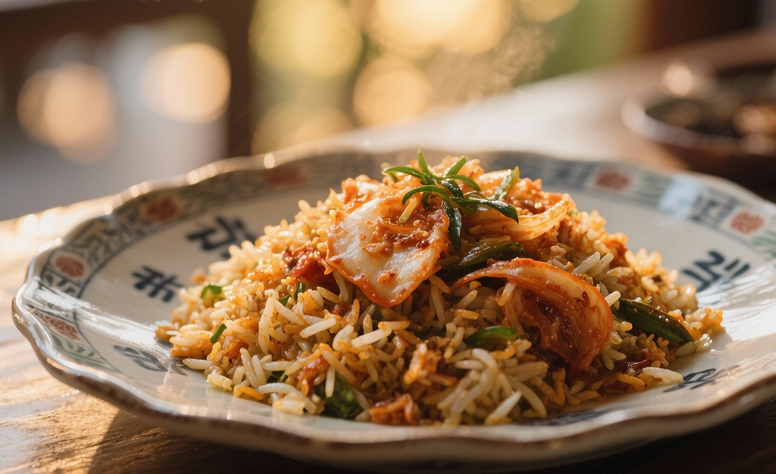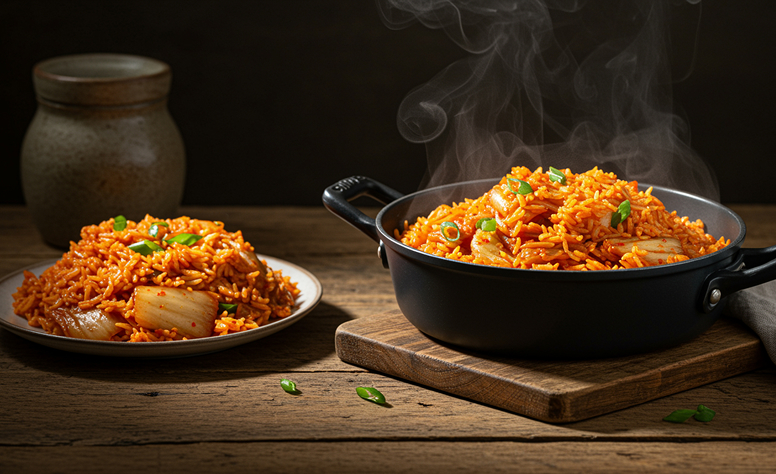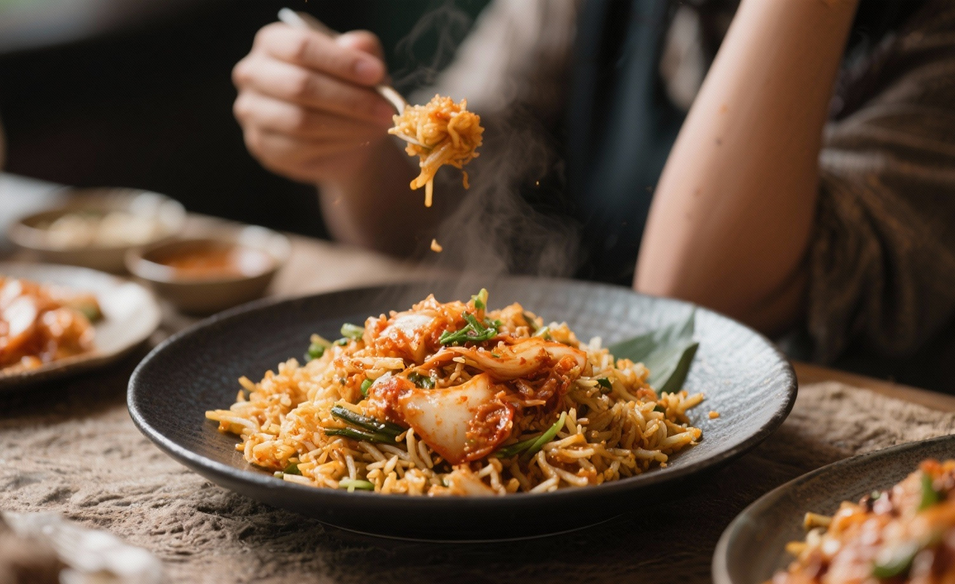Table Of Content
- What Even Is Korean-Style-Biryani?
- Can Korean Elements Complement Biryani?
- How To Make A Korean-Style-Biryani Bowl At Home?
- Nonvegetarian Korean-Style-Biryani Bowl
- Approximate Nutrition (per bowl)
- Ingredient List (Serves 2–3 bowls):
- How To Cook:
- Vegetarian Korean-Style-Biryani Bowl
- Approximate Nutrition (per bowl)
- Ingredient List (Serves 2–3 Bowls):
- How To Cook:
- My Verdict On Korean-Style-Biryani Bowl
If we can have Korean burgers at nearly every popular fast-food franchise, why can’t we have Korean-style-biryani? Well, the wait is over as I have brought to you the ultimate recipe for the best (read “best” again) biryani bowl with a Korean twist.
I have honestly spotted several small eateries on Instagram, promoting that they have launched their new menu by blending these two flavors together. And I have visited a few of these.
At first, I was a little skeptical. However, when I first took a bite, the umami hit the right spot. Which is why I decided to recreate this Korean-Indian fusion dish on my own.
So, if you are trying to get the right recipe that is going to be easy to make for beginners, you have come to the right place. Therefore, keep on reading till the end…
What Even Is Korean-Style-Biryani?

Trust me when I say this, never did I ever imagine that I would try a Korean variant of one of my favorite dishes, biryani. But somehow, after I tried it, I realized that the tanginess of the kimchi and the spices of the traditional biryani just came together very well.
So, what is a Korean-style-biryani?
Gaining traction pretty recently, this dish (which is also known as kimchi biryani) basically mixes certain elements of Korean cooking with the traditional flavors of the biryani that we know.
One of the reasons why this “mashup,” as Asian Community News calls it, has been becoming popular is because “both cuisines are bold, flavorful, and celebrate the joy of spices.”
Basically, Korean flavors in Indian cooking is something that most people are trying out. I genuinely (and personally) don’t think it’s going to take too long for more restaurants and popular food chains to pick up on these.
But while you wait for Korean style biryani to become readily available in almost all food places, why don’t you learn the quickest and the easiest way of making it? At. Home.
Yes, this is possible. And trust me. Besides, if I could do it, you can do it too!
Can Korean Elements Complement Biryani?
Good question. And the answer to this is yes. And this is because one of the major characteristic elements of Korean cuisine is its balance of sweet, spicy, and savory flavors. This offers a very interesting contrast to the bold and spicy flavor of the traditional biryani we know.
For instance, some of the primary things that you can use when it comes to cooking biryani with a Korean twist are gochujang and doenjang. These two primary and extremely traditional Korean items can be used in biryani as a marinade, giving the meat (or even your veggies if that’s your thing) a distinct Korean flavor without overpowering it.
Moreover, Korean-style raita is also something that you can make as an accompaniment to your main dish to give a little extra fusion twist.
How To Make A Korean-Style-Biryani Bowl At Home?

| Serving Size | Prep + Cook Time | Rough Nutrition Per Bowl* |
|---|---|---|
| 1 generous bowl (400 g) | 15–20 min prep + 25–30 min cooking = 40–50 min total | 500–650 kcal 18–25 g fat 60–80 g carbs 20–35 g protein |
*These are ballpark estimates. Below, in each variation, I’ll provide a more detailed breakdown (based on common biryani nutrition data provided by Nutritionix).
I have made this Korean-style biryani about 7 times. While my go-to option is chicken when it comes to meat, you can customize according to your preference. Also, I have added a vegetarian version of the same recipe.
Nonvegetarian Korean-Style-Biryani Bowl
Approximate Nutrition (per bowl)
- Calories: 550-600 kcal
- Carbs: 70 g
- Fat: 18–22 g
- Protein: 30–35 g
Ingredient List (Serves 2–3 bowls):
- 1 cup (200 g) basmati or long-grain rice, rinsed and soaked for 20 min.
- 250 g boneless chicken thigh or breast, cut into bite-sized pieces.
- 1 small onion, thinly sliced.
- 1 teaspoon ginger, minced
- 2 cloves garlic, minced.
- 1 green chili (optional), slit.
- 1 tomato, chopped.
- 1tbsp gochujang (Korean chili paste).
- 1tbsp soy sauce.
- 1tsp sesame oil.
- 1tbsp vegetable oil or neutral oil.
- ½ teaspoon turmeric.
- ½ teaspoon garam masala or biryani masala.
- Fresh cilantro/coriander leaves for garnish.
- ½ teaspoon red chili powder (optional).
- Salt, to taste.
- Kimchi (on the side or layered).
- Sliced scallions.
- Toasted sesame seeds
How To Cook:
- Prep the rice: Once rinsed and soaked, rice should be left to drain.
- Marinate chicken: Half a tablespoon of soy sauce, a pinch of salt, and a little gochujang should be mixed with the chicken pieces in a bowl. Let the mixture stand for 10 minutes.
- Saute aromatics: A blend of vegetable oil and sesame oil is heated in a heavy pot or deep pan. Onions, garlic, ginger, and green chili are added. Onions are allowed to become translucent and slightly golden by sauteing them.
- Spice & tomato: To the mixture, turmeric, biryani masala, and red chili powder are added. Next, the chopped tomato is stirred in, and the cooking is continued until the tomatoes soften and the oil separates from the mixture.
- Cook chicken: The marinated chicken is added. After searing the chicken for 2–3 minutes, the remaining soy sauce and a splash of water (about ½ cup) are added. The chicken is cooked for 8–10 minutes in a tenderizing way.
- Layer rice: Carefully add the drained rice to the chicken mixture, and lay it evenly over the top. About 1 to 1 1⁄4 cups of water or chicken stock are added (just enough to cook the rice). Salt is also adjusted.
- Dum/steam: A tightly fitting lid is used to cover the pot. After bringing to the boil, the heat is turned to minimum and the pot is left there for 10–12 minutes. Rice is done and cooked with steam.
- Rest & fluff: The lid is removed after turning off the heat and letting it rest for 5–7 minutes. The chicken and rice are mixed evenly, and the rice is gently fluffed up.
- To serve: Put a generous mound in a bowl. Chop cilantro, scallions, sesame seeds and optionally a small side of kimchi or Korean pickles. Sprinkle them on top.
Vegetarian Korean-Style-Biryani Bowl
Approximate Nutrition (per bowl)
- Calories: 450–500 kcal
- Carbs: 65–75 g
- Fat: 12–15 g
- Protein: 12–18 g
Ingredient List (Serves 2–3 Bowls):
- 1 cup basmati or long-grain rice (rinsed & soaked).
- 100 g firm tofu or paneer, cubed.
- 1 small onion, thinly sliced.
- 2 cloves garlic, minced.
- 1 teaspoon ginger, minced.
- 1 tomato, chopped.
- ½ cup green peas.
- 1 tbsp gochujang.
- 1 carrot, diced.
- 1tbsp soy sauce.
- 1tbsp vegetable oil.
- ½ teaspoon turmeric.
- ½ teaspoon biryani masala (or garam masala).
- Salt, to taste.
- Fresh cilantro/coriander leaves.
- Kimchi.
- Toasted sesame seeds.
- Scallions.
How To Cook:
- Prep rice: Rinse, soak, and drain the rice.
- Saute aromatics: Place a pot on the stove, heat oil in it. Additionally, add chopped onion, minced garlic, and grated ginger, and cook until the onions are soft.
- Spice & tomato: Stir in turmeric, biryani masala, and tomato. Then let it cook until the tomato is soft.
- Add vegetables & tofu: Incorporate diced carrot, peas, and tofu cubes to the mixture. Season with soy sauce, gochujang, and a little water. Cook for about 5 minutes until the vegetables are tender and still have some bite.
- Add rice + water: Carefully lay the soaked rice over the vegetable-tofu mixture. Add water (or vegetable stock) about 1 to 1¼ cups so that it is just covering the rice.
- Steam cook: Put the lid on, bring to a boil, then lower the temperature to a minimum. Then let it cook for 10–12 minutes until rice is tender and water absorbed.
- Rest & mix: Allow the rice to rest for 5 minutes, then using a fork, gently mix the layers.
- Serve: Fill bowls with the cooked rice, sprinkle with fresh cilantro, sesame seeds, and scallions. If you like, serve with kimchi or Korean pickled vegetables on the side.
My Verdict On Korean-Style-Biryani Bowl
I really don’t lie when I speak about food. So, you need to trust me when I say that this Korean-style-Biryani recipe that I have shared with you is the ultimate thing. And the ONLY thing you need to get the delicious umami flavors in no time.
Also, for those who have been thinking whether you should make kimchi or gochujang from scratch, it is totally up to you. Literally any kimchi is fine. I have always made it with store-bought kimchi, and it doesn’t taste bad at all.
However, if you want to go that extra mile, you can definitely use homemade kimchi. In that case, use the quantity depending on how old and fermented the kimchi is.
Try this recipe and share what it was like!













